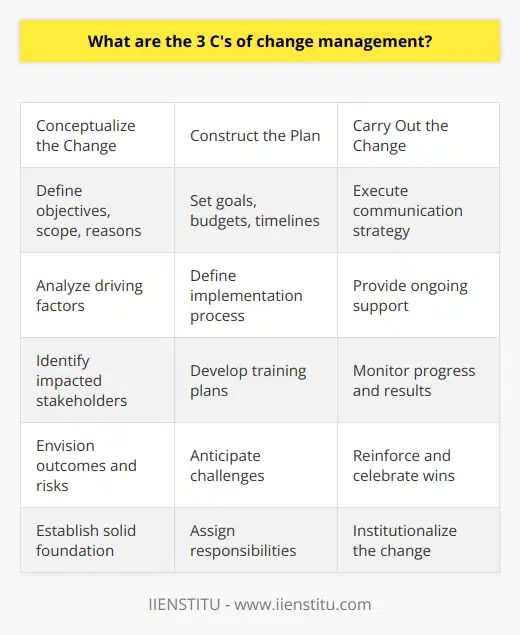
Change management is a discipline that is growing in importance in today’s fast-moving, unpredictable business climate. It is a set of processes and tools designed to help organizations strategically shift their operations and business models. Change management enables organizations to proactively manage change, anticipate and prepare for potential challenges, and maximize the benefits of transformation initiatives.
This article provides a comprehensive overview of change management, the benefits of transformation in change management, the challenges of change management, strategies for facilitating change management, and recommendations for success.
Overview of Change Management
Change management is a structured approach to transitioning individuals, teams, and organizations from a current state to a desired future state. It is concerned with adopting new processes, systems, technologies, and strategies and the effects these changes have on the people involved. Change management aims to ensure that changes are adopted smoothly and that disruption to business operations is minimized. Change management also ensures that all stakeholders are informed, engaged, and supported throughout the transition.
The Benefits of Transformation in Change Management
Transformation is a key component of change management. By embracing transformation, organizations can unlock numerous benefits, such as improved efficiency, increased productivity, enhanced customer experiences, and greater agility. Transformation can also drive innovation, enabling organizations to develop new products, services, and processes better suited to customers' needs.
Challenges of Transformation in Change Management
Despite its potential benefits, transformation can be challenging to implement. Organizations must be prepared to overcome various obstacles, such as resistance to change, limited resources, and lack of clarity around objectives. Additionally, transformation initiatives often require significant time, money, and personnel investments. It is therefore important that organizations carefully assess the potential costs and benefits before embarking on any transformation journey.
Unlocking Niches: Divisional Structure for Successful Corporations
The Most Important Key to Leadership Success: Emotional Energy Management
Strategies for Facilitating Transformation in Change Management
Organizations can use various strategies to facilitate transformation in change management. Establishing a clear vision for the future and communicating this vision to stakeholders is essential. It is also important to ensure that the organization has the necessary resources and capabilities to support the transformation. Additionally, organizations should focus on developing the skills and competencies of their staff, providing them with the tools and training they need to succeed in the new environment. Finally, measuring and monitoring progress is important to ensure the transformation is on track.
Conclusion and Recommendations
Change management is a complex and challenging discipline that can generate significant rewards for organizations willing to embrace transformation. Organizations must be prepared to overcome a range of obstacles and invest in the necessary resources and capabilities. By establishing a clear vision and engaging stakeholders, investing in staff development, and measuring progress, organizations can maximize the potential benefits of transformation initiatives. With the right approach, organizations can unlock the full potential of change management and unlock transformation.
The key to transformation lies in the successful management of change
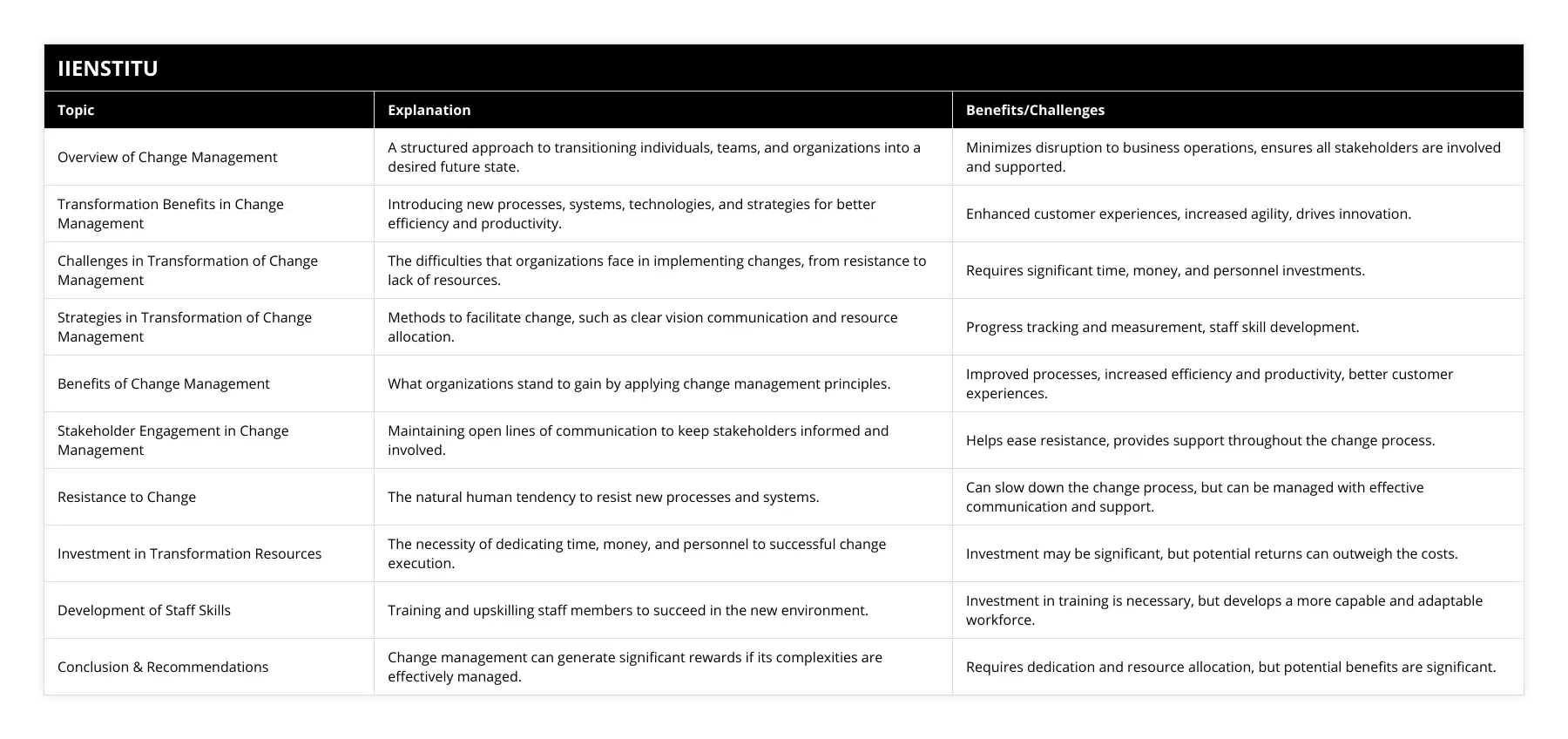
Frequently Asked Questions
What is change management and what are the benefits of transformation in change management?
Change management is the process of implementing organizational change in order to achieve desired outcomes. It involves planning, organizing, and controlling the people, processes, and systems that drive successful change initiatives. Change management is a critical component of any organization's success in adapting to the ever-changing environment.
Change management is a broad discipline that combines principles from business strategy and operations management with human resource planning and development. This enables organizations to effectively manage changes in their business environment by anticipating and responding to them quickly, efficiently, and effectively. Change management encompasses activities such as developing an organizational structure for effective implementation of change initiatives; developing communication plans; creating training programs; identifying potential risks associated with change initiatives; preparing stakeholders for the transition; managing stakeholders' expectations; and evaluating progress against objectives.
The benefits of transformation in change management are vast. By taking a proactive approach to managing changes in the workplace, organizations can reap significant gains in terms of improved efficiency, reduced costs, enhanced customer experience, improved employee engagement, increased innovation opportunities, and better decision making. Additionally, change management can help organizations align their operational strategies with their mission objectives more effectively by providing better visibility into how operations are performing against goals set out by leadership teams or external stakeholders such as investors or customers.
In order to successfully benefit from transformation through effective change management practices it is important for organizations to have a clear understanding of what they need to achieve through their transformation efforts as well as how best to implement those efforts within their particular context. Additionally, it is important for leaders within an organization be actively engaged throughout the process in order ensure buy-in from all levels of employees impacted by changes being made. Finally, it is essential for organizations to review progress on an ongoing basis so that they may adjust strategies when needed based on feedback received from employees or other stakeholders impacted by changes implemented throughout the organization’s transformation process.
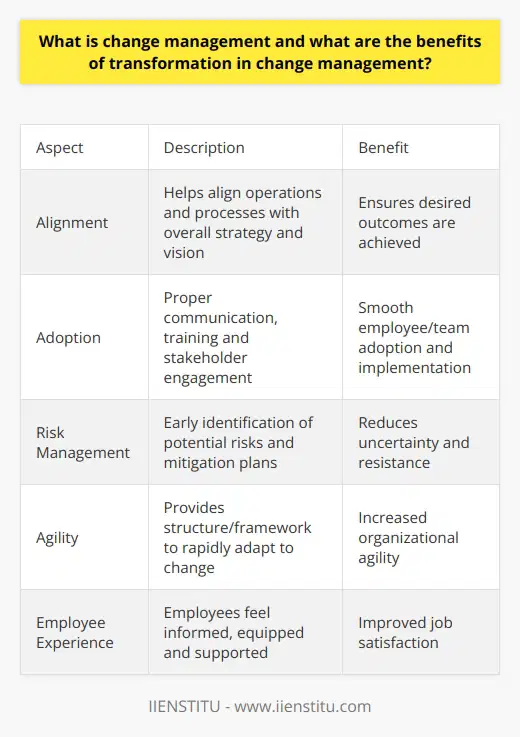
What challenges can organizations face when implementing transformation in change management?
Organizational transformation is a process of restructuring and re-organizing the way in which organizations operate and the manner in which they interact with the external environment. It is a process of change management that involves a range of activities such as organizational restructuring, process redesign, and technology adoption. However, this process can be challenging, and organizations can face a variety of issues when attempting to implement transformation.
One of the primary challenges faced by organizations when implementing transformation is the difficulty of managing the change process. Organizations must ensure that all stakeholders are aware of the transformation and have an understanding of its purpose and implications. Furthermore, organizations must ensure that all changes are effectively communicated and that all stakeholders are given the opportunity to contribute to the process. This can be a difficult task, as stakeholders may have different perspectives and interests that must be taken into account.
Another challenge faced by organizations is the complexity of the transformation process. Organizations must take into account a range of factors, from technology adoption to organizational restructuring. Furthermore, organizations must ensure that all stakeholders are adequately informed of the transformation process and that the process is implemented in a timely manner. This can be a complex and time-consuming process, and organizations must ensure that they have the necessary resources to carry out the transformation effectively.
Finally, organizations must also be prepared to deal with resistance to the process of transformation. This can be a challenge, as stakeholders may be resistant to change and may view the transformation process as disruptive or unnecessary. Additionally, stakeholders may have different opinions on the transformation process and the changes it will bring, and organizations must ensure that they are able to address these issues effectively.
In conclusion, organizations can face a variety of challenges when attempting to implement transformation in change management. These challenges include managing the change process, dealing with the complexity of the transformation process, and managing resistance to the process. Organizations must be prepared to address these issues in order to ensure that their transformation efforts are successful.
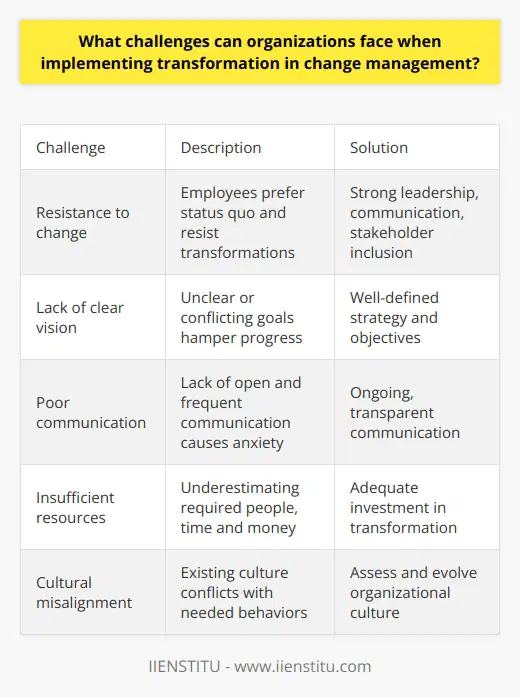
What strategies can organizations use to facilitate transformation in change management?
Organizational transformation is an essential part of any successful change management process. Organizations must have effective strategies in place to ensure that the transformation process runs smoothly and results in meaningful, lasting changes. This article will discuss some of the strategies organizations can use to facilitate organizational transformation in change management.
The first strategy organizations should consider when facilitating transformation is creating an environment of trust between leadership and employees. This means establishing a culture of openness, mutual respect, and collaboration between all stakeholders involved in the change process. Leaders should also be aware of employee’s existing skills and capabilities, as well as their potential for growth, so they can create an environment that encourages personal and professional development.
Another strategy organizations can use to facilitate transformation is implementing a clear communication plan that outlines the objectives of the change process, how it will be implemented, and who is responsible for each step along the way. This plan should also include regular updates on progress made by team members so everyone involved knows what needs to be done next. Additionally, leaders should provide employees with enough resources and support throughout the process so they feel empowered to make decisions and take actions that lead to successful outcomes.
Organizations can also facilitate transformation by encouraging collaboration between different departments or teams within the organization. Creating forums or other platforms for idea-sharing allows different perspectives to come together and generate creative solutions for challenges faced during times of changing processes or structures within an organization.
Finally, organizations should consider offering incentives or rewards for employees who are actively engaged in the change process. These incentives could include recognition awards or financial bonuses depending on how much effort each person puts into making positive changes during the transition period. Incentives help build motivation among team members while also giving them a sense of ownership over their work during times of transition or organizational restructuring.
Overall, these strategies are essential for facilitating effective organizational transformation during periods of change management within any organization. By creating a culture based on mutual trust between leadership and employees; implementing a clear communication plan; encouraging collaboration across teams; and offering incentives for active engagement in the change process; organizations can ensure they are well-equipped to handle any transitions successfully while still effecting meaningful changes that result in long-term success
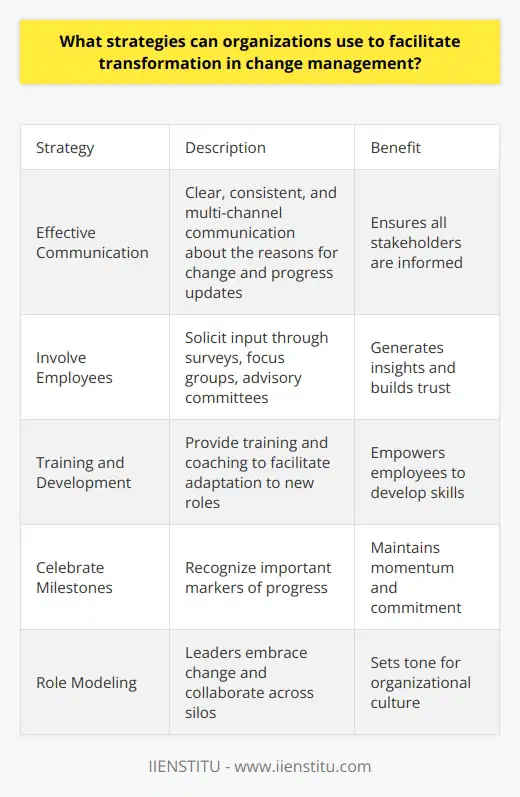
What is the difference between transformational change and change management?
Understanding Transformational Change
Transformational change fundamentally alters the nature of an organization. It reshapes attitudes, culture, values, structures and systems. This kind of change often involves restructuring, merging, or radical strategic shifts. The goal of transformational change is to enable organizations to adapt and flourish within a volatile and complex environment.
Distinguishing Change Management
On the other hand, change management is the systematic approach to dealing with changes within an organization. Unlike transformational change, change management is not necessarily about the major reshaping of an organization. It could occur on a larger or smaller scale. This process aims to ensure smooth transitions, minimizing potential resistance while ensuring that changes are effective.
Key Differences
The key distinctions between transformational change and change management relate to the scope, impact, and strategies used. Transformational change is about redefining an organization’s existence and is often a reaction to significant external or internal pressures. It’s also about preparing the organization for the future by altering its core.
On the other hand, change management tends to be a more proactive process, focusing on achieving specific outcomes within the existing organizational framework. It is about ensuring that the organization can cope with changes which may arise from various factors within and outside the organization.
In conclusion, while transformational change and change management share the common goal of evolving an organization, they diverge significantly in their objectives, strategies, and impacts. Identifying the appropriate approach depends on the scale of change required, the desired outcomes, and the specific circumstances of the organization.
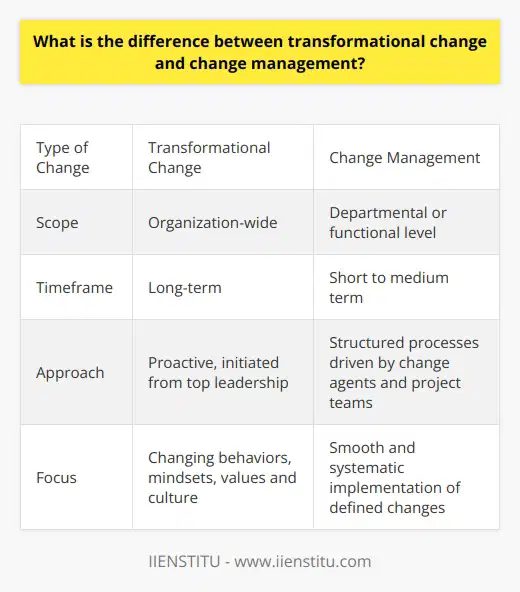
What are the 5 phases of managing change?
Understanding the Change Process
The change management process comprises five comprehensive phases: recognizing the need for change, planning, implementing, managing the transition, and sustaining the change.
Identifying the Need for Change
The initial and crucial step in managing change requires identifying the reasons precipitating the change. This necessitates an in-depth assessment of current practices, procedures, and systems.
Planning for Change
Planning is the second phase, where managers establish the detailed steps or strategies needed to facilitate the desired transformation. It includes setting objectives, identifying potential barriers, and making requisite resource allocations.
Implementing the Change
The third phase involves the actual enactment of the proposed alterations, modifications or strategies. This stage is where the previously set plans become actions to accomplish the change.
Managing the Transition
After implementation, the management must guide their team through the transition. This phase may include addressing any feelings of uncertainty, providing training, and ensuring the adoption of new procedures.
Maintaining the Change
The final phase concerns the permanence of the change. It necessitates continuous monitoring and feedback to ensure the implemented changes function as planned and yield the desired results over the long term.
Essentially, change management requires a strategic and methodical approach to deliver sustainable and effective transformation in an organization. It is a process that requires constant attention, communication, and proactive management at every stage to successfully navigate organizational changes.
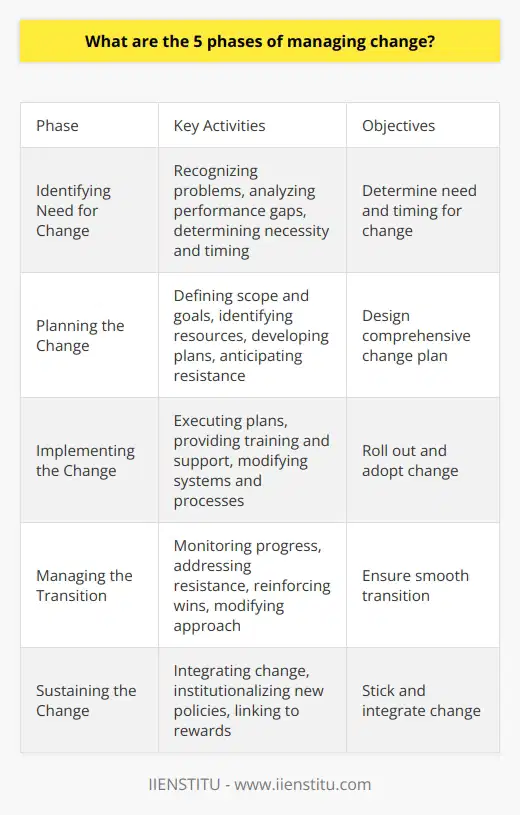
What are the 3 C's of change management?
Understanding the 3 C's of Change Management
Conceptualize the Change
The first 'C' stands for Conceptualize. It refers to understanding and envisaging the change that organizations ought to implement. Leaders must clearly define the change in terms of objectives, implications, and potential outcomes. This stage involves a detailed assessment of the current state, a envisioned future and the strategic path to achieve it.
Construct the Plan
The second 'C' in change management is Construct. This phase demands the development of a comprehensive plan to guide the change process. Tasks, timelines, resources, and responsibilities should be allocated meticulously. Leaders need to strategize the change management plan, considering the organization's unique dynamics, culture, and readiness for change. They also need to create contingencies to combat potential challenges and crises.
Carry Out the Change
The final 'C' stands for Carry Out. It pertains to the execution of the devised plan. It involves communicating the change to stakeholders, executing the actions, monitoring the progress, and making necessary adjustments. Efficacious communication is central during this stage to keep everyone involved informed and motivated. The process can include training sessions, mentorship programs, regular updates, and gathering feedback. Ultimately, the effectiveness of carrying out the change is dependent on sustained commitment, resilience, and flexibility.
In conclusion, the three C's of change management – Conceptualize, Construct, and Carry Out, provides a succinct overview of the process and stages involved in managing organizational change. Comprehending and employing these principles empowers leaders to steer their organizations effectively through periods of transition and enhance productivity, engagement, and overall success.
